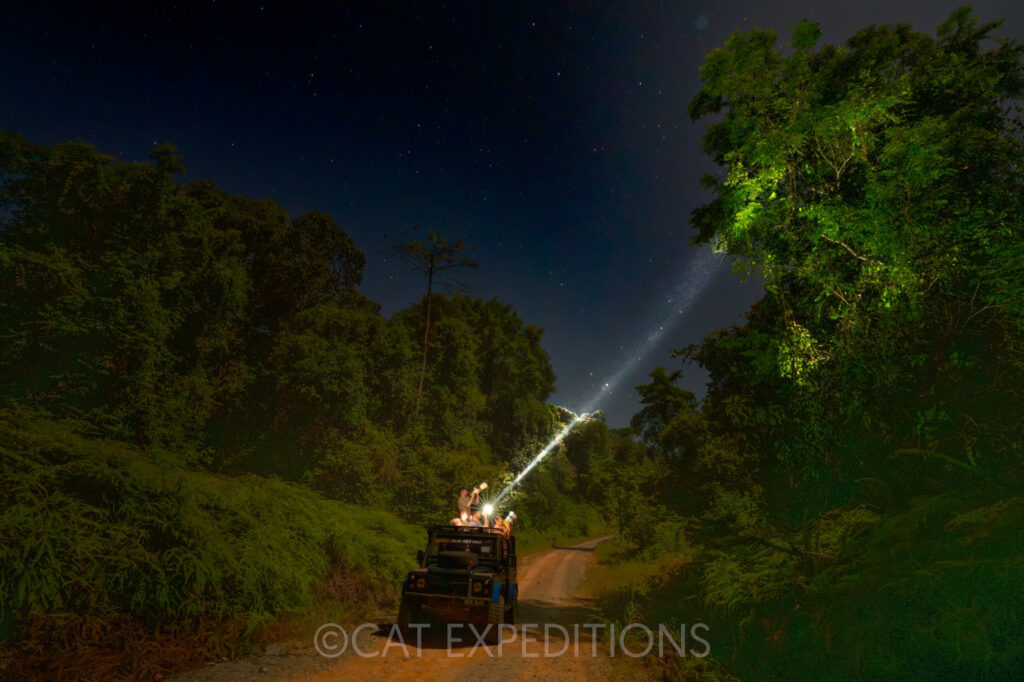For our annual Cats of Borneo photo tour, we visited the Malaysian state of Sabah in north-eastern Borneo. Borneo is one of the biodiverse places on earth and has some incredible tropical rainforest remaining on the island. We saw a total of two species of wild cat in Borneo, including the super rare and elusive flat-headed cat! Read the rest of our Cats of Borneo Photo Tour 2024 Trip Report to get all the details!
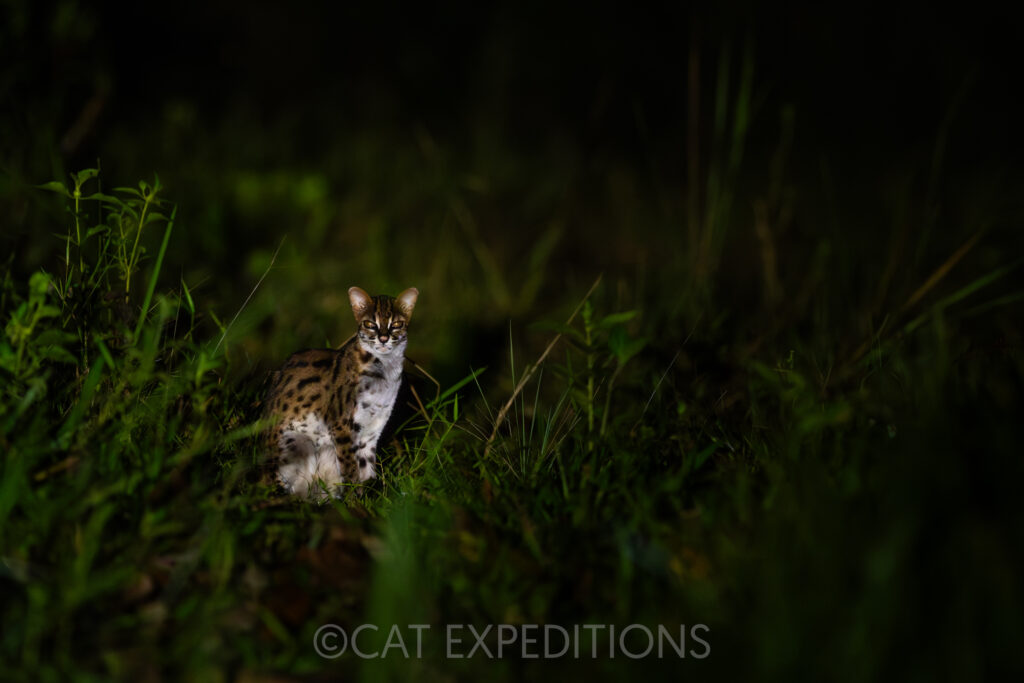
Highlights of the 2024 Cats of Borneo Photo Tour
Sunda Leopard Cat: We had an astounding 35 leopard cat sightings throughout Deramakot and Tabin. We had cats walk right past our vehicle, hunt in front of us, climb a tree, run past us with a mouse in its mouth. We even had one opportunity to approach a cat on foot in Deramakot. 9 cats in a single night was our all-time high, with so many incredible photographic opportunities!
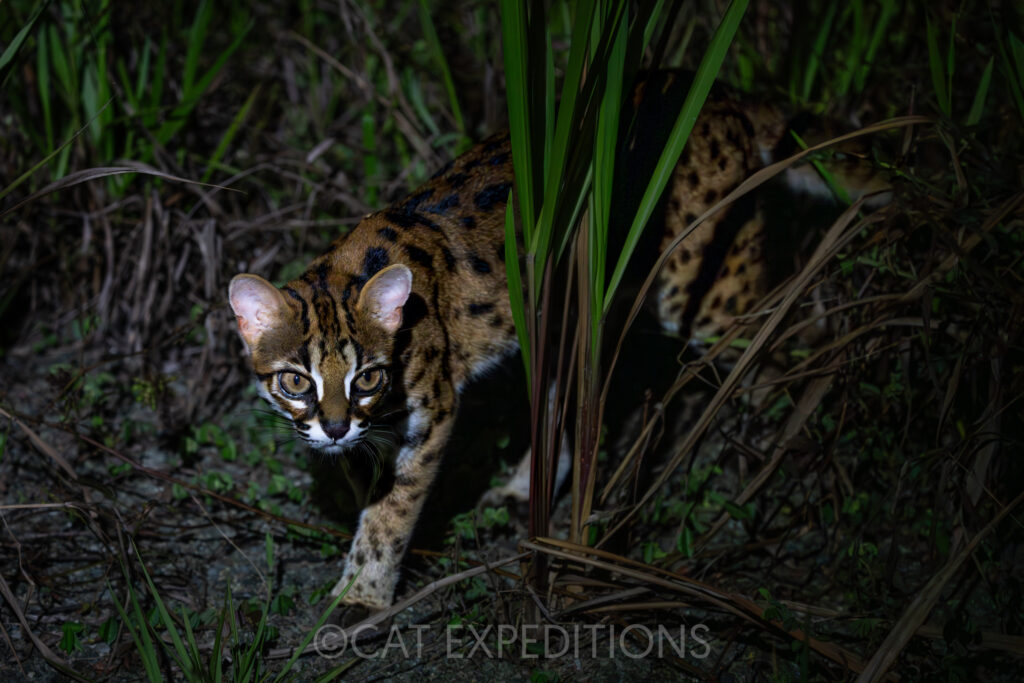
Flat-headed Cat: What an amazing highlight! We were extremely fortunate to have spend one evening with a Flat-headed Cat during one of our nights on the river. With a lot of patience and stellar spotting and boat maneuvering, we had four different sightings of the cat as it walked along the river’s edge.

Mammals: We saw 35 different species of mammals. Some of the highlights included five orangutan, including a mother and baby at eye level, 7 Malay Porcupines, several Banded Civet, including one in a tree which is quite rare to see, a group of very active Giant Red Flying Squirrels, and a 5 Borneo Pygmy Elephants, including a very small baby!
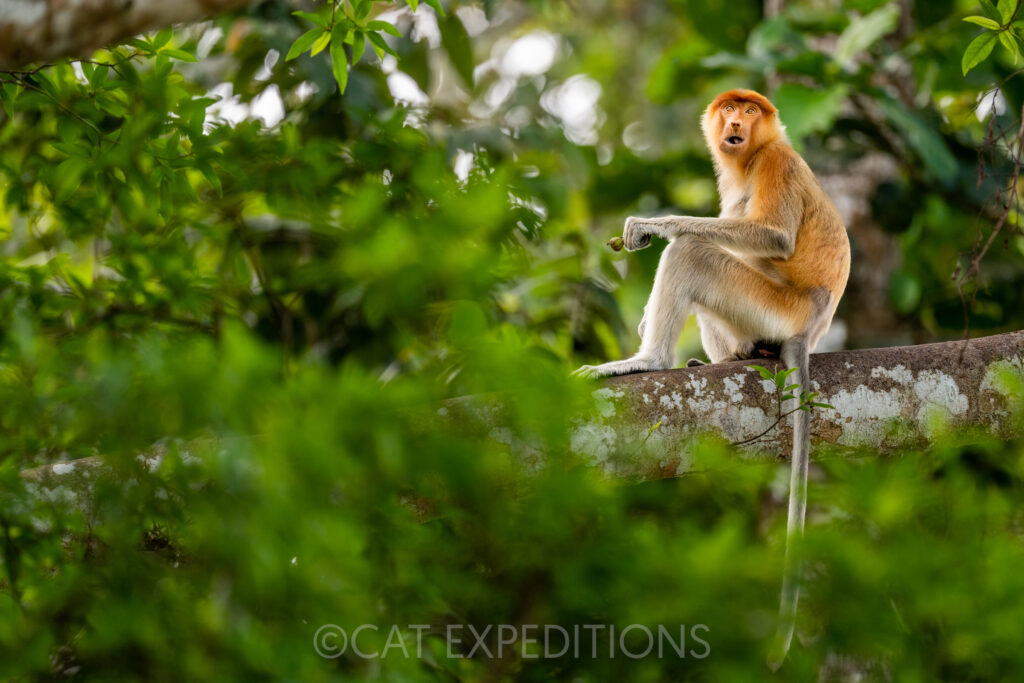
Reptiles: We saw 9 different reptiles, including some very cool snakes, including a Borneo Pit Viper, a Reticulated Python and a melanistic Dogtooth Cat Snake that nearly took a ride with us.
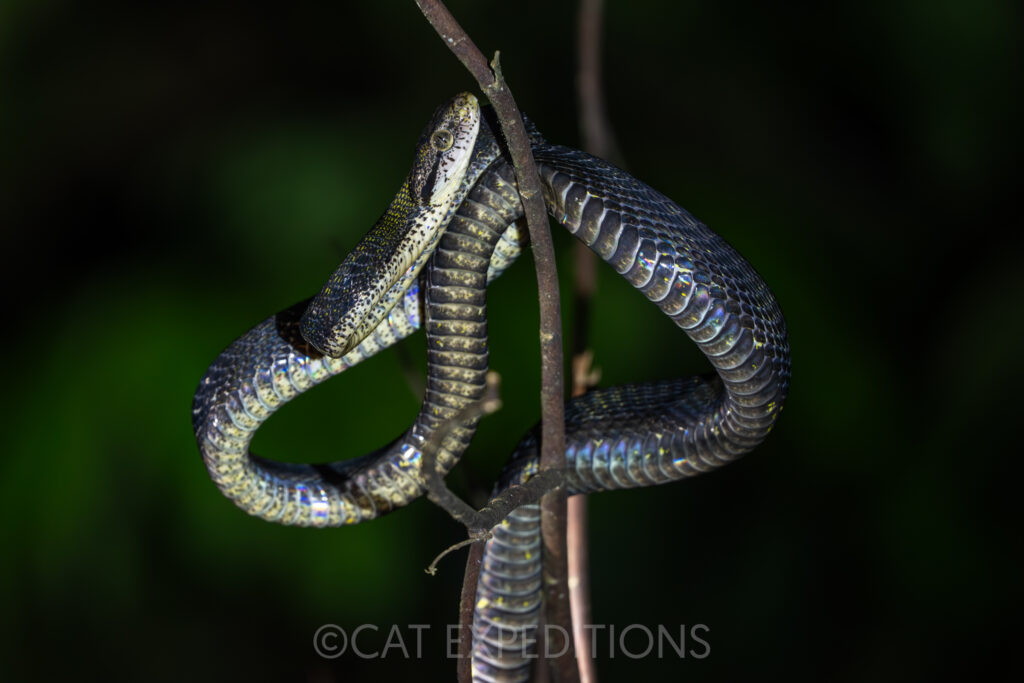
Birds: We saw 40 different bird species, including 6 of the 8 species of Hornbill present in Borneo. The Rhinoceros hornbills feeding on figs at our lodge in Tabin was a true highlight.
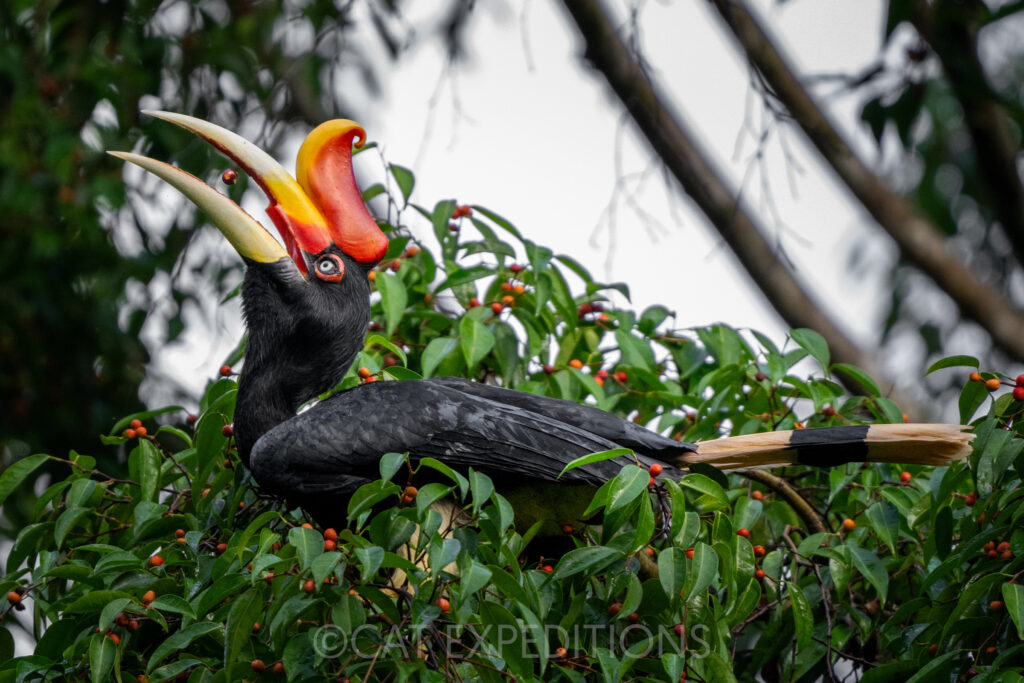
Detailed Cats of Borneo Trip Summary 2024
Day 1: Despite a near-miss travel delay due to erupting Mount Ruang, we all thankfully made it on time to Sabah, Borneo via Sandakan. Our home base was Sepilok Nature Lodge, which had lovely chalets surrounding a small water body, where we spotted herons and sunbirds from the restaurant. The lodge was walking distance to the Rainforest Discovery Center, and we kicked off the trip with a night walk through the canopy, led by our local guides Mike and Vendon. After watching a Giant Flying Red Squirrel emerge from its nest box and fly away into the night, and listening to the 6pm cicadas make their distinctive sound, we too walked into the darkness, spotting nocturnal creatures like a Borneon Pit Viper, and our first Phillipine Slow Loris.
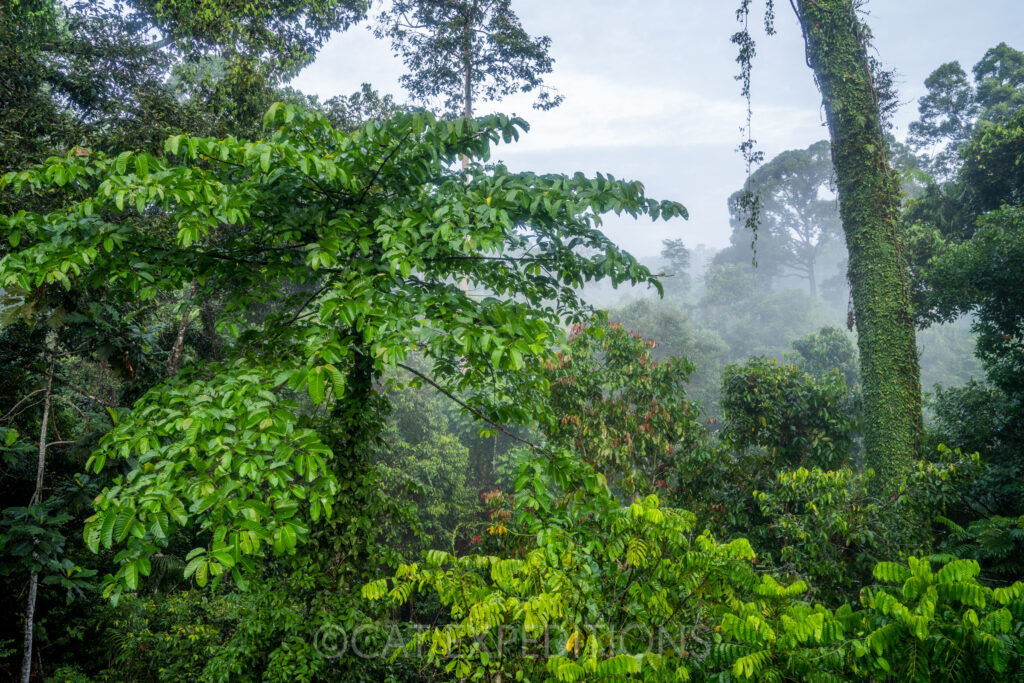
Day 2: At sunrise, we walked back to the Rainforest Discovery Center for a daytime view of the canopy, hoping for primates and birds, among other diurnal species. We enjoyed the boisterous calls of the Borneon Gibbons and got a good glimpse of them swinging through the trees. It was a quiet morning, apart from a Flying Lizard, who did indeed fly, and a Common Water Monitor swimming through the pond!
It was then time to make the drive to Deramakot. We drove approximately 3 hours by van before stopping for lunch and switching into 4WD vehicles that would take us the rest of the way, another 2 hours through oil palm plantations and finally into the Deramakot Forest Reserve. We settled into our accommodations, which are small chalets managed by the Forestry Service.
We did a short night drive after arriving. Highlights included our first Island Palm Civet with a pup right outside camp, a Small-toothed Palm Civet, 3 Greater Mouse Deer, and a great look at a File-Eared Frog.
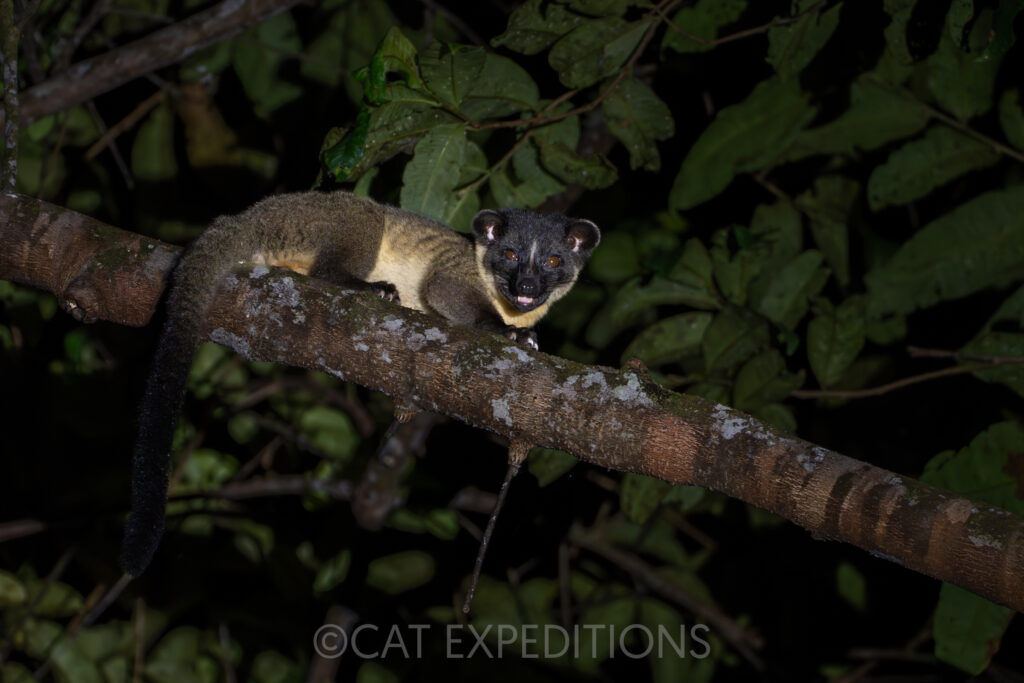
Day 3: Our nocturnal schedule began here in Deramakot. After lunch (and a spiderhunter that we got an up-close-and-personal look at after it flew into the restaurant window), we all managed to get some afternoon rest in preparation for our first full night out; drives begin at 7:00p and last until roughly 3:00a, depending on what we would find.
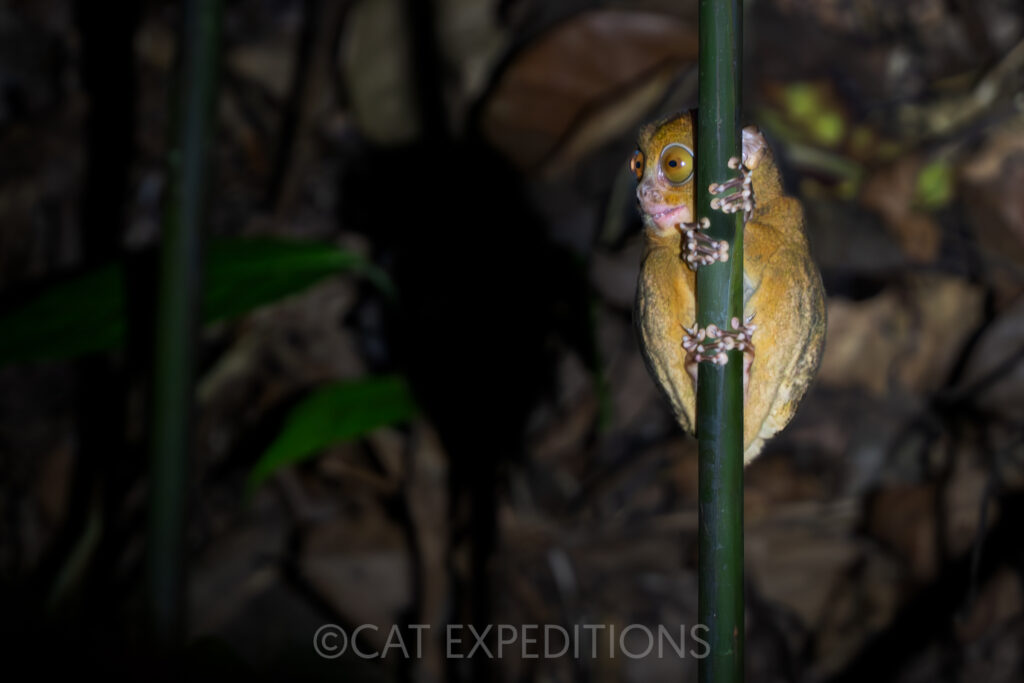
We had our first big rain right off the bat on our drive, putting all of our rapid rain gear dressing skills to the test! Luckily, it was short-lived, and we spend the rest of the night spotting thirteen different mammal species, including a Yellow-Footed Martin, Thomas’ Flying Squirrel and Malay Civet. The highlight of the drive was almost certainly the Western Tarsier with a baby, and jumped up a vine to grab it before leaping out of sight.
Day 4: The night of the Sunda Leopard Cats! We had four leopard cat sightings on this evening. Two in particular gave us some very special looks. Sebastian led the group on foot to approach the third cat down a side road that proved to be very productive. We spent about 45 minutes with the cat, who gave us some might fine looks, before heading off to do whatever it is leopard cats do in the night. A fourth cat showed up just as we were leaving the previous sighting, and we observed it sniffing the rocks along the road before it wandered off. It was such a productive evening, that we didn’t get back until nearly 4:00a!
Other highlights of this drive included a very well-hidden Binturong, a Reticulated Python right along the road, some sleeping Bushy-crested Hornbills, and our first Colugo, or what we affectionately referred to as ‘the blob.’
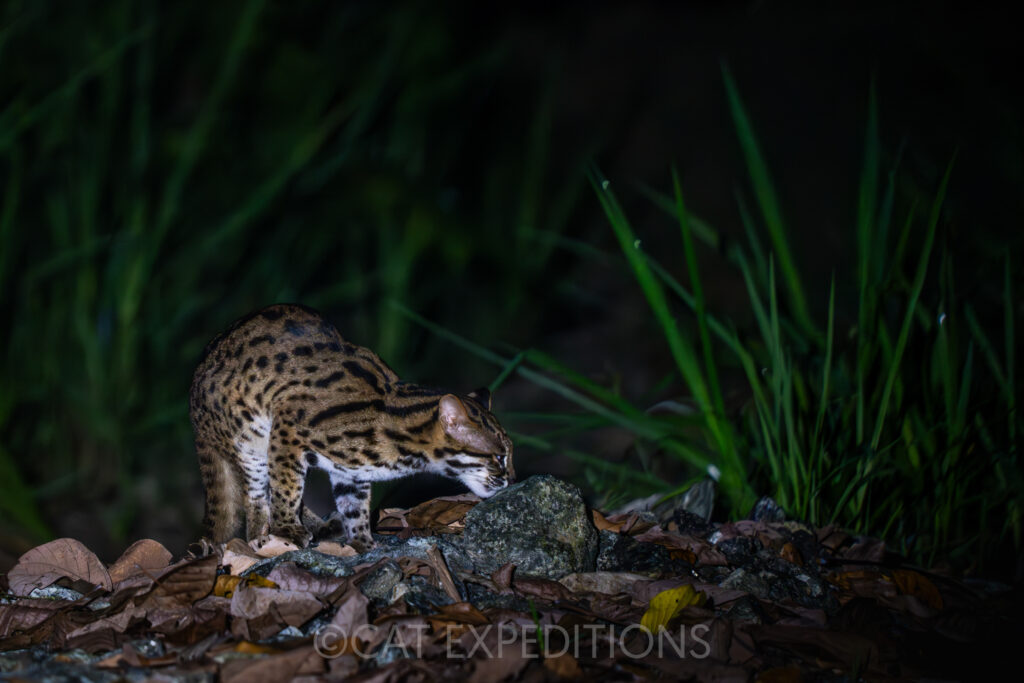
Day 5: We were quickly settling into the new schedule; some of us would sleep until late morning, waking up in time for lunch, while the other half of us would wake up for a quick breakfast, and then head back to sleep until later in the afternoon. Many of us have relied on copious amounts of kopi (coffee), of the bagged variety, which was actually quite delicious.
Our third night drive was a full moon and a bit of a quieter one, though we did have a leopard cat right off the bat. The thermal cope helped us spot a couple of well-hidden Colugos, and Mike had some excellent eyesight spots of some small critters, like a Lesser Ranee Mouse, a Trefoil’s Horseshoe Bat, and a small, Spotted Cat Snake. We also saw our first Buffy Fish Owl, which would be numerous throughout the trip in all three locations.
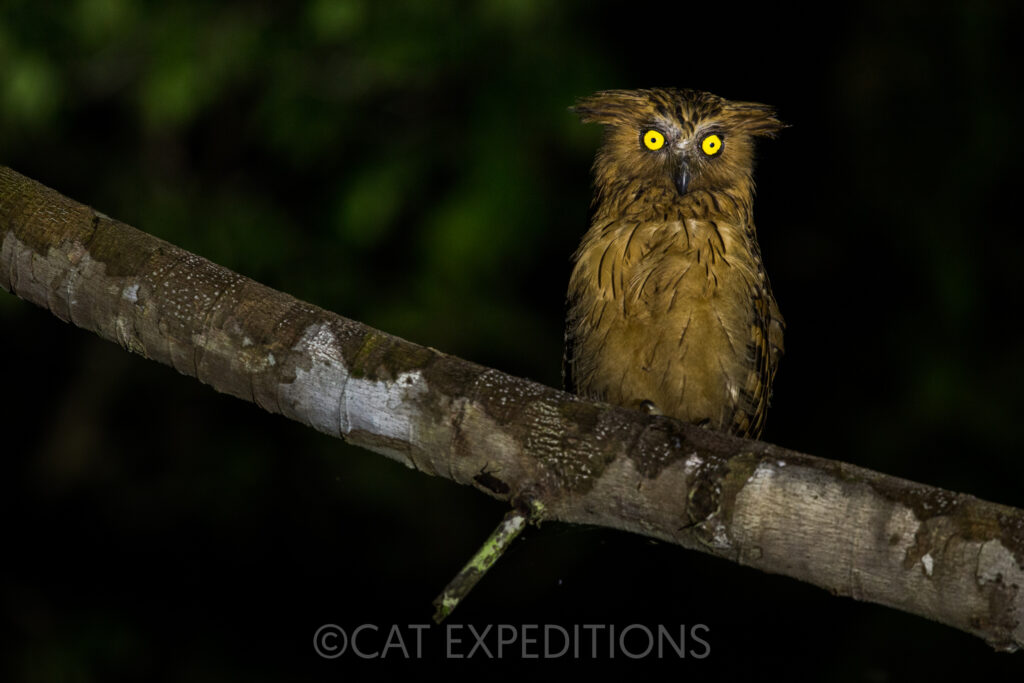
Day 6: The search for cats continued. We had two leopard cats on this drive, but it proved to be the drive of the civets. We say 3 Malay civets, 3 Island Palm Civets, 2 Bornean Striped Palm Civets and 2 Banded civets including one that came right up to the vehicle and was hunting in some of the rocks along the side of the road; a highlight of the drive and resulting in some beautiful photos.
While spotlighting, we sometimes came across sleeping, diurnal animals. We don’t light them up to make sure not to disturb their sleep, but on this drive we did drive by a sleeping Orangutan, Long-tailed Macaque, and a female Bornean Crested Fireback.
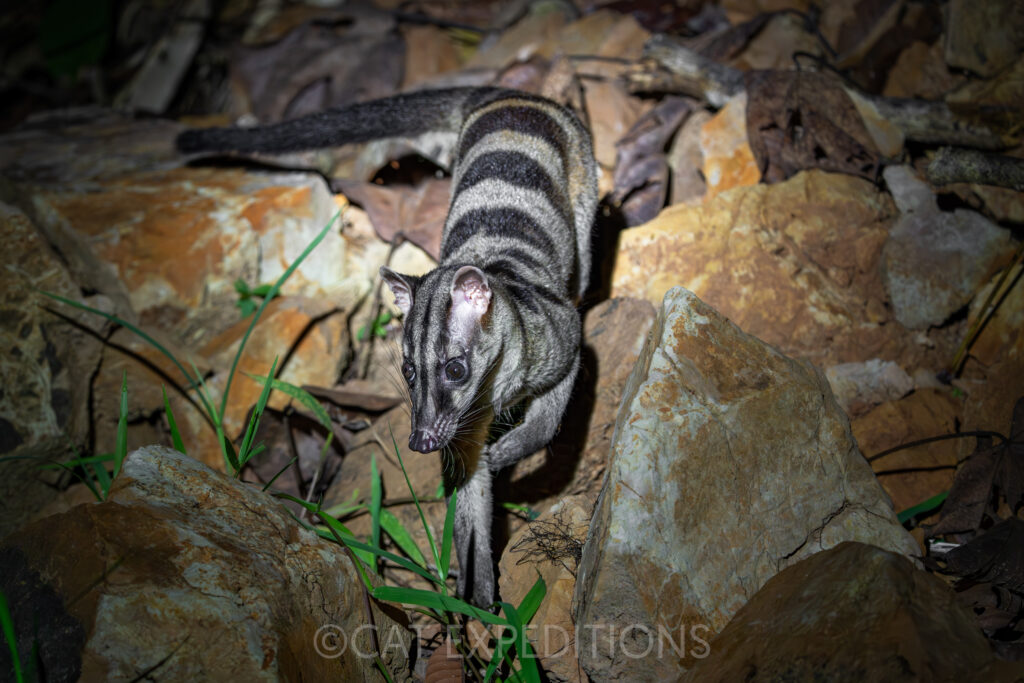
Day 7: With a waning moon, we had a little bit more time out on drive before the moonrise, which gave us a short glimpse of the stars. We saw an early leopard cat, and found a second towards the end of the drive. After seeing it initially, it went into the bushes along the road. Sebastian had us drive ahead, turn off the car and the lights and wait for it to re-emerge. It was a great call; the cat came out, and walked toward us, giving everyone the opportunity for some beautiful head-on shots.
We saw three new mammal species, including a Dark-tailed Giant Rat, a Sunda Skunk, and a Bornean Yellow Muntjac, as well as a Boobook, a type of owl that we were quite lucky to see! We also had a beautiful view of an Island Palm Civet scent-marking very close to the vehicle.
It was a bit of a wild drive, with a handful of moments that made us jump, to say the least! We had a ridealong cicada that gave Rosemary a bit of a scare, two tree falls off the road, the sound of which put a fire in our ride, and a melanistic Dogtooth Cat Snake that nearly made its way into Charlie and Adam’s seats as we drove by it. Always something exciting out in the bush!

Day 8: Our last day in Deramakot. Our schedule today would include our first drive in daylight, in the hopes of seeing some orangutans and possibly other diurnal species. After some Lightroom lessons and a later lunch, we headed out onto the main road at 4:00p. It was very cool to see the forest in a different light, though it was hot, the late afternoon sun was quickly behind the canopy, and it was a very comfortable drive.
Right off the bat, we saw our first orangutan, a male on his own, foraging in a tree. We watched him for awhile and then continued on. Ahead of the vehicle, three Asian Small-Clawed Otters ran across the road; very rare to see!
Soon after, we found another small group of orangutans. First, a male, eating in a tree just off the road. We were able to get out of the vehicle and explore some different angles on foot. While Fazi was having a cigarette several meters behind the vehicle, he spotted two more orangutans: a mom and a baby who had settled into the nest for the evening. They laid there looking at us, the baby’s head curiously popping up every now and then to check us out and look around. It was wonderful to observe these two at eye level as the sun was going down.
As it got dark, the leopard cats started coming out. We had four different leopard cat sightings; one cat right next to the vehicle, posing beautifully on a log. Another walked right by the vehicle, so close that most of our longer lenses couldn’t capture it!

This was the first night we made it all the way to the river, the full 28km. We had a picnic lunch by the river near the Forestry Department buildings, where monkeys slept in the trees and where we also got to see the women’s bathroom Sebastian had called home for his last assignment! As we were leaving, Mike spotted a Pentailed Tree Shrew on a tree by the road. “Pentailed tree shrew!”, he shouted. “This is a top-tier mammal you guys!” His excitement was infectious, but sadly the tree shrew scampered out of sight before anyone else got a glimpse. However, we did get a peek at a pair of Malayan Porcupine walking through the bushes as we made our way back to our chalets.
Day 9: We departed Deramakot first thing in the morning, at 7:30a. We had a 2.5-hour drive to the main road, where we switched into a van that would take us another 2.5 hours to the Kinabatangan River. The river would be the main place we would look for Flat-Headed Cat, though we would also be looking for Clouded Leopard. Once we arrived at the river, we were picked up by our boat captain and taken about 5 minutes downriver to the Borneo Nature Lodge, a small lodge right on the river with nice little chalets and a warm staff.
After lunch, we headed out on our first afternoon boat ride. The Kinabatangan River is an excellent place for birds, including hornbills, and primates during the day, and these would be our targets during our daily morning and afternoon drives. Indeed, we had a great afternoon with the monkeys after a quick rain; many Long-tailed Macaques, Pig-tailed Macaques, a handful of Silver Langurs (also called Silver-Leaf Monkeys), and Proboscis Monkeys. The Proboscis monkeys were very interesting to watch, with the large males very active, and females with babies jumping from tree to tree.
After a dinner back at the lodge, we geared up once more for our night ride, which started at 9p. Our focus: Flat-headed cat. We spent time along both the main channel and some of the smaller tributaries, scouring the edges of the river bank for flat-headed cats that could be hunting frogs and rodents along the shoreline or in the reeds. We used both the spotlight and the thermal scope to look for eye shine and heat. We all had to remain completely silent; there were more than one high-intensity moments, with one ‘might-have-been’ but unconfirmed sighting. Lots of rodents, owls, and a banded civet confirmed. We returned to the lodge around midnight.
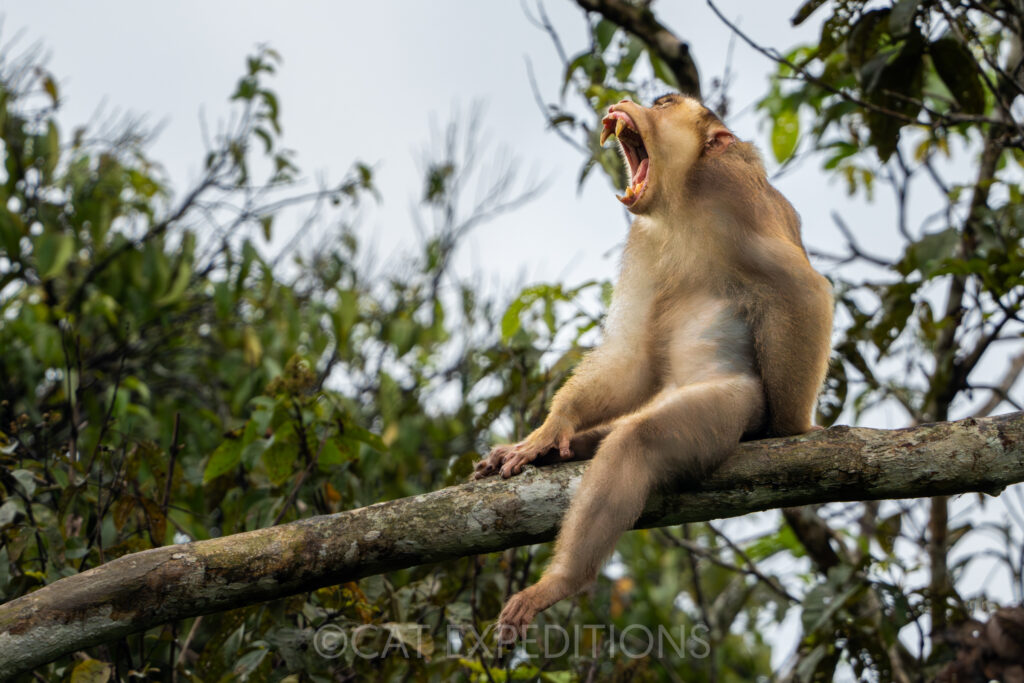
Day 10: We started the day with a 6:30a morning drive. Mike spotted a Triangle Keelback snake swimming right as we pulled off the dock. We saw more Proboscis Monkeys, as well as a large group of Bornean Gibbons (about five individuals).
We saw three different kingfishers on this drive: the Blue-eared Kingfisher, the Stork-billed Kingfisher, and the Ruddy Kingfisher, which was a highlight for everyone on this drive. We watched it hunt three times, and it let us get very close, getting beautiful views of its brilliant purples. What a sight!
Between the morning and afternoon drives, we had three different hornbill sightings: Black Hornbill, Wrinkled Hornbill and Oriental Pied-Hornbill.
Unfortunately, Mike’s son had a medical emergency around dinnertime and he had to leave for the hospital in a hurry. We were all very sorry for his leaving and for his family, but his son had excellent care and ended up being in good shape after some stitches. We were left in wonderful hands with our boat captain and spotter, Janu, who insisted we spend more time on the river that night to maximize our chances for the cat. He took us to a couple of different spots and we spent time silently but intensely scouring the bushes and the beaches for the cat. Finally, Sebastian spotted eye shine that looked promising and we confirmed it was a flat-headed cat in the thermal. It had been hunting in a large, open spot on the river, taking advantage of the low tide. After just a few moments, it walked back into the forest and out of sight.
We decided to go a bit further up, wait quietly for awhile, and see if it came back out to that spot. We were rewarded for our patience; when we returned, it was back, and everyone got a very clear view of it, although it ran off quickly after we spotted it. We repeated the leave, sit, wait and return pattern two more times, and were able to get a total of four sightings of the cat, before we lost it for good. What a thrilling sighting!
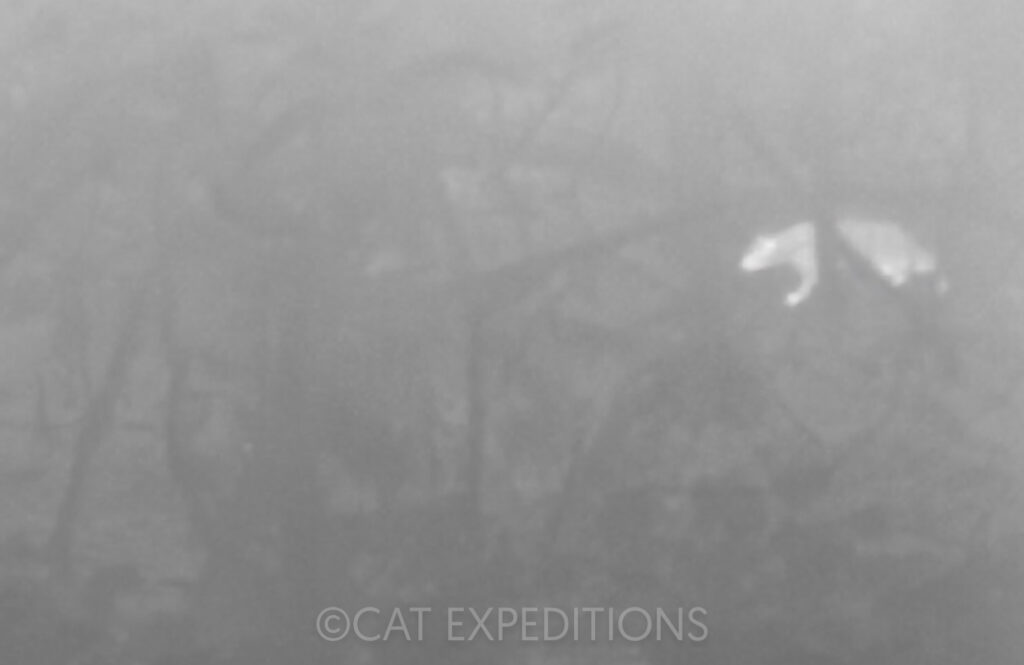
Day 11: Our morning drive was quiet, with some long-tailed macaques and pig-tailed macaques, and a few beautiful looks at kingfishers.
After a rest in the afternoon and some very heavy rain, we headed out for our afternoon drive. There had been reports of elephants way up river, so we decided to go for it. It took about 45 minutes to get to the spot, and as we arrived, there were two elephants walking along the edge of the river, though mostly obscured by foliage. We got a couple of very short looks before they disappeared into the forest.
Janu drove up a bit as we looked to see where they might have walked or might re-emerge, but no dice. We returned the other way, and pulled into a small bank to look at some big elephant tracks. After a few minutes, we pulled out and were about to start our drive back to the lodge when we spotted a few elephants drinking right on the bank of the river, just a few hundred meters from where we were pulled in. We watched two adults drinking and as one stepped to the side, a tiny baby elephant was revealed; it must have been about two months old! Such a fortunate and special sighting!
Later that night, we went out on our final night drive. We opted to stay out a bit later and tried again to find the Flat-headed Cat. We hoped we had one a couple of times, but the cat eluded us this time around. It was a late night, however, and we didn’t get back until 2:30am.
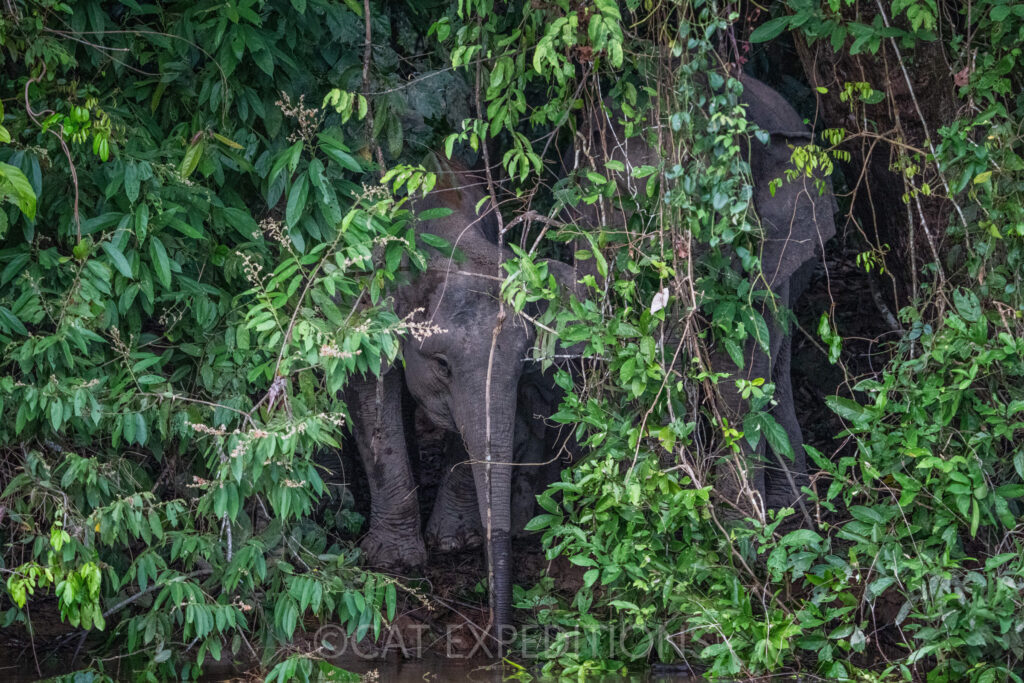
Day 12: After the late night, everyone took advantage of some extra sleep and opted out of a morning boat ride, which in the end was a wise decision! We departed the hotel at 9:30a and met our van across the river. It was a 2.5-hour drive to Lahad Datu airport, where we switched into 4WD vehicles and registered with the wildlife lodge. It was another 1.5 hours through oil palm fields to get to Tabin Wildlife Resort, our base for the next three days. We’d be focused on Marbled Cat and Clouded Leopard here, and would be following a similar schedule as in Kinabatangan: morning drive, afternoon drive, and night drive.
This was the nicest lodge we stayed at throughout the trip; the river chalets were quite nice, with balconies overlooking the river, including the gibbons and hornbills that would spend time at camp. When we arrived, we had both of these species, plus a large group of pig-tailed macaques. It just so happened that the large fig tree right in the center of the property started fruiting that week, and it was bringing in these fig-loving species in great numbers.
We did our first afternoon drive out on the main road, practicing photographing flying Rhinoceros hornbills. We also got a good look at our first White-Crowned Hornbill, a very cool bird that has a fluffy white mohawk!
We returned for dinner, and then left promptly at 7:45 to be sure to be the first vehicle on the road for the first chance at any potential cats that might be out near the road. We started with our first moonrat, a large, possum-like rat completely white in color.
It was then a leopard cat bonanza! The combination of habitats in Tabin, oil palm and forest, mean high prey availability for the Sunda Leopard Cat. Rodents are plentiful, and with the heavy rains we had in the afternoon, so were frogs. (The cacophony of frogs was amazing!) It felt as though we saw a leopard cat around nearly every corner. In total, we saw 9 Sunda Leopard Cats that night, beating Alister’s single-night record of 8 cats!
We also saw our first Barred Eagle Owl, but just a glimpse, as well as some Greater Mouse Deer, a Banded Civet, and an Island Palm Civet.
After exploring the core area road as well, we got back to the lodge around midnight.
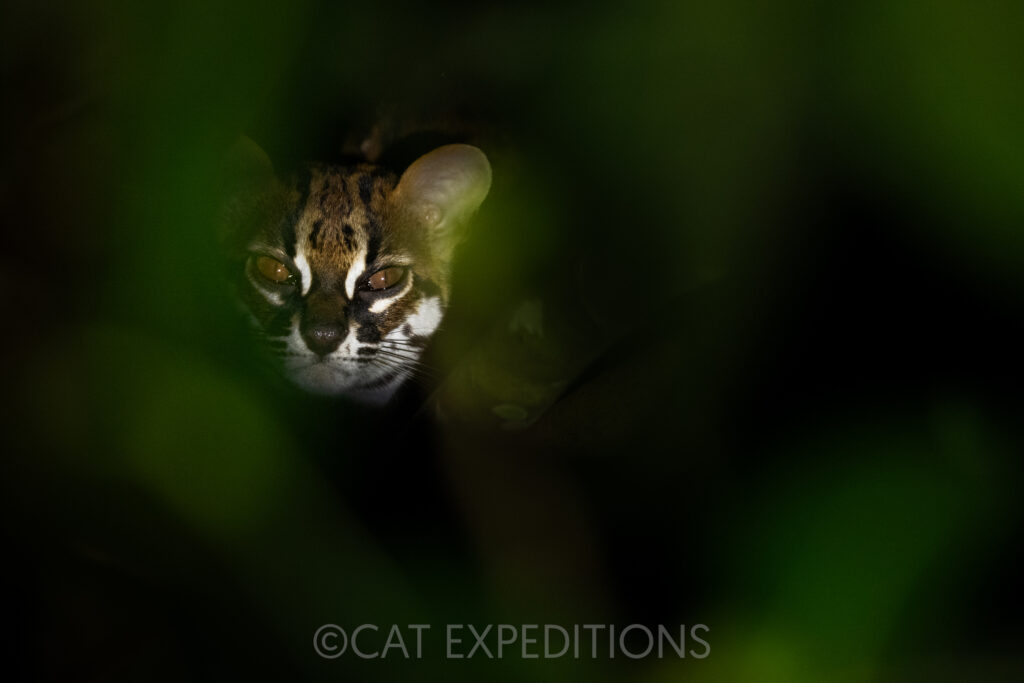
Day 13: Because the trees were fruiting, we opted to spend the morning at camp rather than on drive. It was a phenomenal opportunity to photograph primates and hornbills up-close with excellent views.
The Rhinoceros Hornbills started flying in right around 6a, perching in the fig tree en masse and feeding on the small, orange figs that were fruiting in the thousands. We photographed them from the suspension bridge, watching them feed and toss figs into the air and catch them in their mouths. We also watched pairs exchange food with each other, listened to their loud, trumpeting calls, saw them cleaning their beaks on broken branches.
The Gibbons didn’t show up for the morning, likely because the Pig-tailed Macaques were there in such large numbers. We observed lots of foraging, grooming, and playing behavior amongst the macaques.
Our afternoon drive was also productive, with some Wreathed and Bushy-Crested Hornbills, as well as our first Collared Kingfisher. We then stumbled upon a group of Giant Red Flying Squirrels that put on a quite a show. They were most likely playing with each other, chasing each other from tree to tree, gliding through the air, back-and-forth. We must have seen 30 different flights, and spent time trying to photograph them in flight!
Our night drive gave the first night a run for its money! 8 Sunda Leopard Cats in total, hitting Alister’s record once again! We had some really beautiful looks, including one posed nicely on the rocks. We often saw them on the oil palm plantation side of the road, which seemed to be a popular hunting ground for them. We also had three Malayan porcupine, including one that walked right to the vehicle, a Western Tarsier, and a couple of different civets.
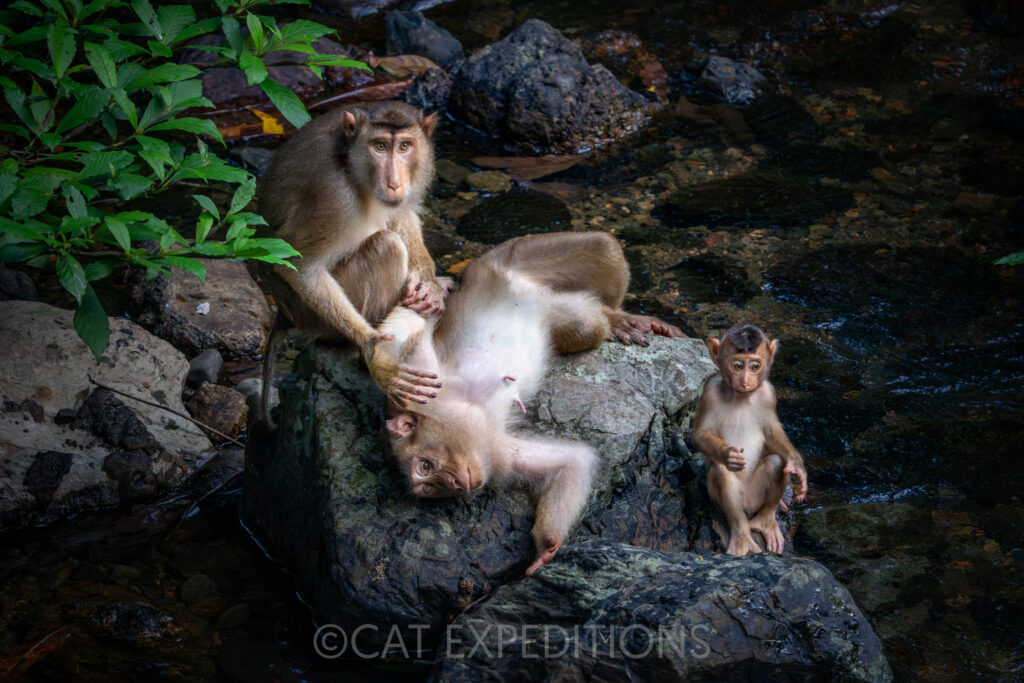
Day 14: Our final day in Tabin and the last day of the Cats of Borneo tour. We took advantage of the wildlife at the lodge once again. This time, the macaques were completely gone and the Gibbons were there! A group of four or five gibbons spent the morning in the fig tree, giving us great opportunities to photograph them. Sebastian also spotted a Pigmy Squirrel, which was very cute and extremely fast!
Though it was a quiet afternoon, we had yet another productive evening, with four more Sunda Leopard Cats, including one climbing up into a tree. We also spotted a Phillipine Slow Loris, some Flying Foxes, four more Malayan Porcupines, and a handful of Mouse Deer.
We returned back to the lodge by midnight, and said some goodbyes before packing up to depart the next morning.
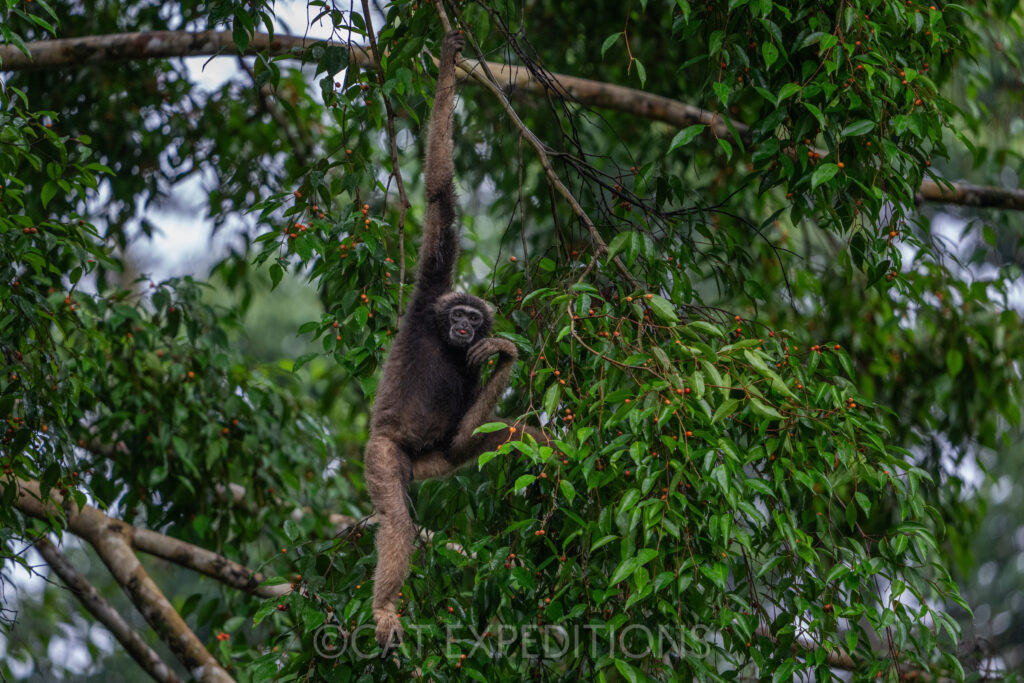
Day 15: Most of us had an early departure from the resort, and headed back to Lahad Datu (1.5 hours through the oil palm) where we started our trek back to our respective homes!
Cats of Borneo Photo Tour 2024 Species List
Mammals
| Moonrat | Echinosorex gymnura |
| Malayan Colugo | Galeopterus variegatus |
| Large Flying Fox | Pteropus vampyrus |
| Trefoil Horseshoe Bat | Rhinolophus trifoliatus |
| Phillipine Slow Loris | Nycticebus menagensis |
| Western Tarsier | Cephalopachus bancanus |
| Silvered Langur | Trachypithecus cristatus |
| Proboscis Monkey | Nasalis larvatus |
| Long-tailed Macaque | Macaca fascicularis |
| Southern Pig-tailed Macaque | Macaca nemestrina |
| Müller’s Bornean Gibbon | Hylobates muelleri |
| Bornean Orangutan | Pongo pygmaeus |
| Prevost’s Squirrel | Callosciurus prevosti |
| Least Pigmy Squirrel | Exilisciurus exilis |
| Black Flying Squirrel | Aeromys tephromelas |
| Thomas’s Flying Squirrel | Aeromys thomasi |
| Red Giant Flying Squirrel | Petaurista petaurista |
| Dark-tailed Giant Rat | Uromys anak |
| Lesser Ranee Mouse | Haeromys pusillus |
| Malayan Porcupine | Hystrix brachyura |
| Flat-headed Cat | Prionailurus planiceps |
| Sunda Leopard Cat | Prionailurus javanensis |
| Yellow-throated Marten | Martes flavigula |
| Sunda Skunk | Mydaus javanensis |
| Asian Small-Clawed Otter | Aonyx cinereus |
| Malay Civet | Viverra tangalunga |
| Island Palm Civet | Paradoxurus hermaphroditus |
| Binturong | Arctictis binturong |
| Borenan Striped Palm Civet | Arctogalidia trivirgata |
| Banded Palm Civet | Hemigalus derbyanus |
| Borneo Pygmy Elephants | Elephas maximus borneensis |
| Greater Mouse Deer | Tragulus napu |
| Bornean Yellow Muntjac | Muntiacus atherodes |
| Sambar Deer | Rusa unicolor |
Birds
| Bornean Crested Fireback | Lophura ignita |
| Green Imperial Pigeon | Ducula aenea |
| Greater Coucal | Centropus sinensis |
| Storm’s Stork | Ciconia stormi |
| Lesser Adjutant | Leptoptilos javanicus |
| Oriental Darter | Anhinga melanogaster |
| Striated Heron | Butorides striata |
| Oriental Honey-Buzzard | Pernis ptilorhynchus |
| Crested Serpent-Eagle | Spilornis cheela |
| Wallace’s Hawk-Eagle | Nisaetus nanus |
| Crested Goshawk | Accipiter trivirgatus |
| White-bellied Sea-Eagle | Icthyophaga leucogaster |
| Gray-headed Fish-Eagle | Icthyophaga ichthyaetus |
| Buffy Fish-Owl | Ketupa ketupu |
| Barred Eagle-Owl | Ketupa sumatrana |
| Brown Wood-Owl | Strix leptogrammica |
| Brown Boobook | Ninox scutulata |
| White-crowned Hornbill | Berenicornis comatus |
| Rhinoceros Hornbill | Buceros rhinoceros |
| Bushy-crested Hornbill | Anorrhinus galeritus |
| Black Hornbill | Anthracoceros malayanus |
| Wreathed Hornbill | Rhyticeros undulatus |
| Wrinkled Hornbill | Rhabdotorrhinus corrugatus |
| Blue-eared Kingfisher | Alcedo meninting |
| Stork-billed Kingfisher | Pelargopsis capensis |
| Ruddy Kingfisher | Halcyon coromanda |
| Collared Kingfisher | Todiramphus chloris |
| Long-tailed Parakeet | Psittacula longicauda |
| Black-and-red Broadbill | Cymbirhynchus macrorhynchos |
| Black-and-yellow Broadbill | Eurylaimus ochromalus |
| Greater Racket-tailed Drongo | Dicrurus paradiseus |
| Slender-billed Crow | Corvus enca |
| Sooty-capped Babbler | Malacopteron affine |
| Asian Glossy Starling | Aplonis panayensis |
| White-crowned Shama | Copsychus stricklandii |
| Malaysian Blue Flycatcher | Cyornis turcosus |
| Crimson Sunbird | Aethopyga siparaja |
| Asian Fairy-Bluebird | Irena puella |
| Lesser Green Leafbird | Chloropsis cyanopogon |
| Dusky Munia | Lonchura fuscans |
